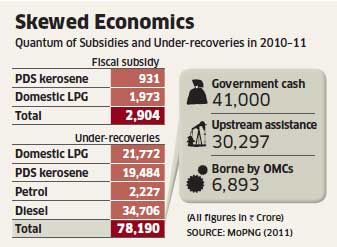Eliminate petroproduct subsidies: Firm decision will improve the health of OMCs
Global oil prices have been high in recent years even as our oil imports keep rising. Plunging value of the rupee adds to this import burden.
Government's decision to raise petrol prices is merely the thin end of the wedge, revealing an aspect of irrational pricing that has afflicted the country for much too long.
Meanwhile, the daunting challenge of bringing down our fiscal deficit looms large. Against this background, the burden of government subsidies has been discussed extensively, but little done to arrest the increasing trend of pricing distortions in the country.
By far the most important challenge in these relates to the energy sector. It is for this reason that The Energy and Resources Institute (Teri) has brought out A Citizen's Guide to Subsidies in India.
Let us look at prices of petroleum products. In 2010-11, the figures estimated for subsidies on petroleum products were staggering, and are getting worse.
The accompanying graphic shows the break-up of these subsidies and their volumes. Three petroleum products - kerosene for the public distribution system (PDS), domestic LPG and diesel - are sold at far less than international market prices with the government providing a fiscal subsidy.

However, this subsidy provides only part of the difference between the cost price (including marketing costs) and the selling price of these petroleum products - resulting in under-recoveries for the oil marketing companies (OMCs) - which are calculated as the difference between the cost price and the regulated price at which the petroleum products are sold by OMCs to retailers after accounting for subsidies paid by the government.
The argument for providing subsidies on LPG is totally irrational, given that LPG is largely the preferred domestic fuel used by the rich and the middle classes, and that too mainly in urban areas.
With kerosene, the perverse nature of subsidies is highlighted by the fact that every reliable survey has found 40-50% of the subsidised kerosene produced going into adulteration of other petroleum products.
Two bright young officers of the OMCs were killed for whistle-blowing on acts of adulteration, and possibly hundreds may be keeping mum under threat of a similar fate.
The political argument for subsidies on kerosene advanced by those favouring status quo is that kerosene is the poor man's fuel for lighting in a large part of rural India. It is unfortunate but true that almost 400 million people in India have no access to electricity, and kerosene is used by a large number of them for lighting.
But if a subsidy is justified for that very reason, which in itself is highly questionable, why is it that a country as advanced in electronics and smart technologies cannot come up with a system of smart cards that could target subsidies only for those below the poverty line and do away with subsidised kerosene in the open market?
It is also relevant to observe that recent research shows emissions from kerosene lanterns in homes as harmful and, in fact, worse, than emissions from cooking with inferior quality biomass burned in inefficient stoves.
If the human and health costs of this pollution were beaccounted for, the questionable benefits from kerosene subsidies would appear negative. It is also significant that in Bangladesh, our neighbour with a lower per-capita income than ours, kerosene is priced at a much higher level than here.
Policies such as subsidising kerosene have become holy cows that politicians are afraid to touch, and which undesirable elements, such as those in the business of adulteration, are delighted to benefit from.
Public initiatives have largely ignored the fact that lanterns based on solar energy are now a viable technology that can compete effectively even with subsidised kerosene, as Teri programme, Lighting a Billion Lives, has established. This option is pollution free, vastly more reliable and devoid of the danger of accidental fires from kerosene.
Public initiatives have largely ignored the fact that lanterns based on solar energy are now a viable technology that can compete effectively even with subsidised kerosene, as Teri programme, Lighting a Billion Lives, has established. This option is pollution free, vastly more reliable and devoid of the danger of accidental fires from kerosene.
Subsidies on diesel also result in growing distortions. First, the move towards passenger diesel vehicles, often the most expensive brands, is only subsidising the rich.
At the macro-level, rational pricing of diesel would certainly make railway freight and passenger options relatively attractive.
It is, of course, true that the Indian Railways has for long shown a lack of vision in expanding and modernising its services. Its shortcomings only compound the incentive that diesel subsidies provide for a shift to greater road transportation even as air pollution in our cities and highways is becoming worse.
Overall, the total value of under-recoveries on petroleum products and the manner in which these have changed in recent years are shown in the accompanying graphic.
The spurt in values during 2008-09 was the result of a sudden spike in global oil prices during that period. A similar spike in future cannot be ruled out even as our dependence on oil imports keeps growing rapidly.
The problem with oil subsidies is also leading to haemorrhage of the OMCs that would otherwise be expected to generate healthy surpluses to facilitate improving their infrastructure and, thereby, reducing the cost of marketing for the benefit of the consumer.
Successive governments have failed to bite the bullet, ironically, even as the administered pricing mechanism was officially dismantled in 2002. When will disastrous politics in this area give way to sensible economics?

